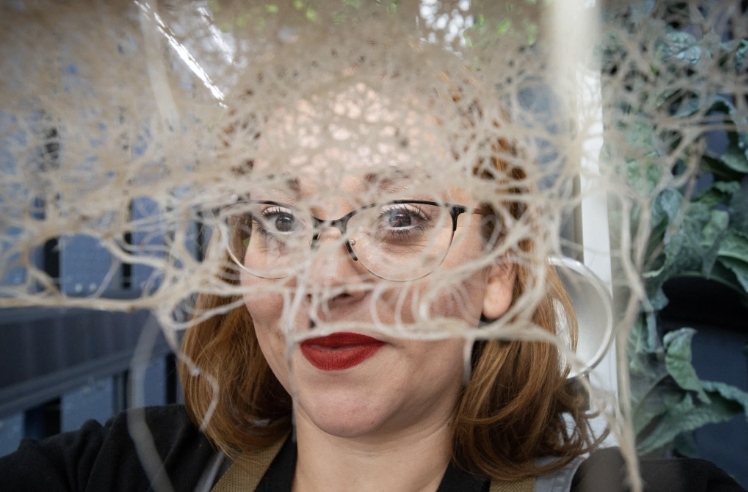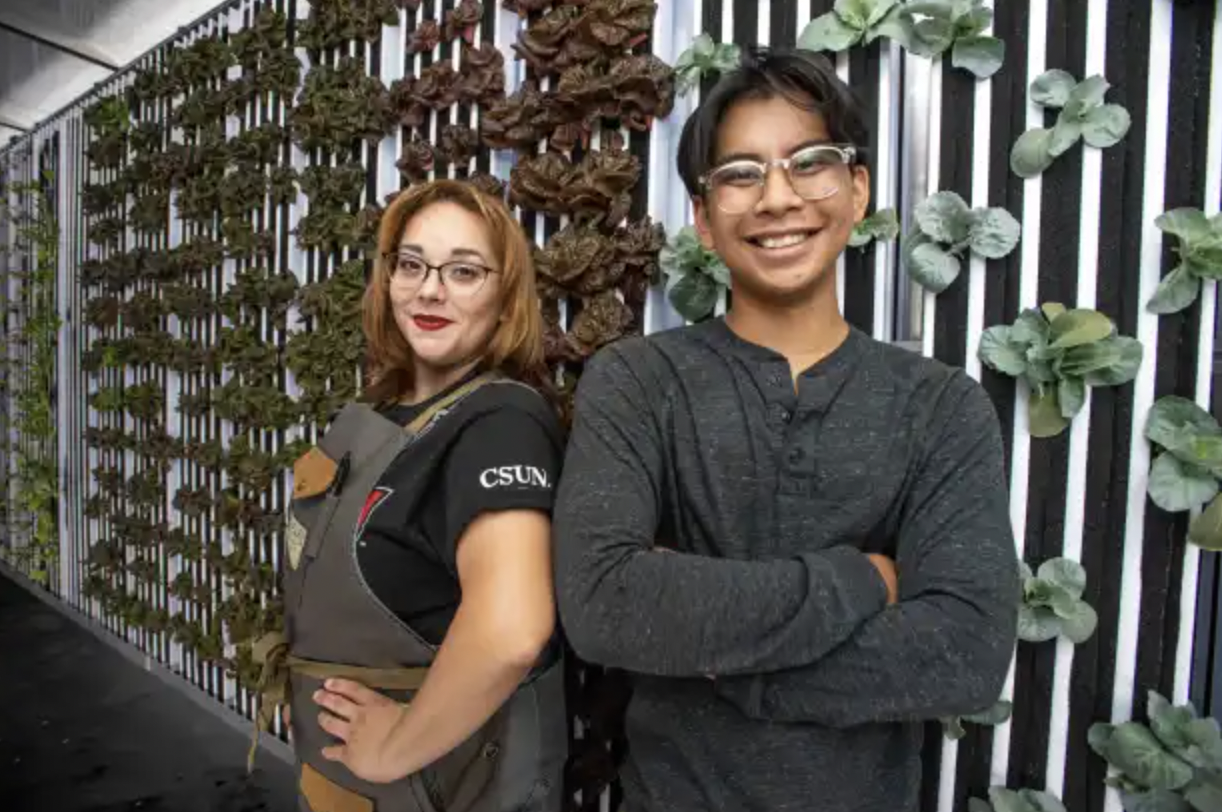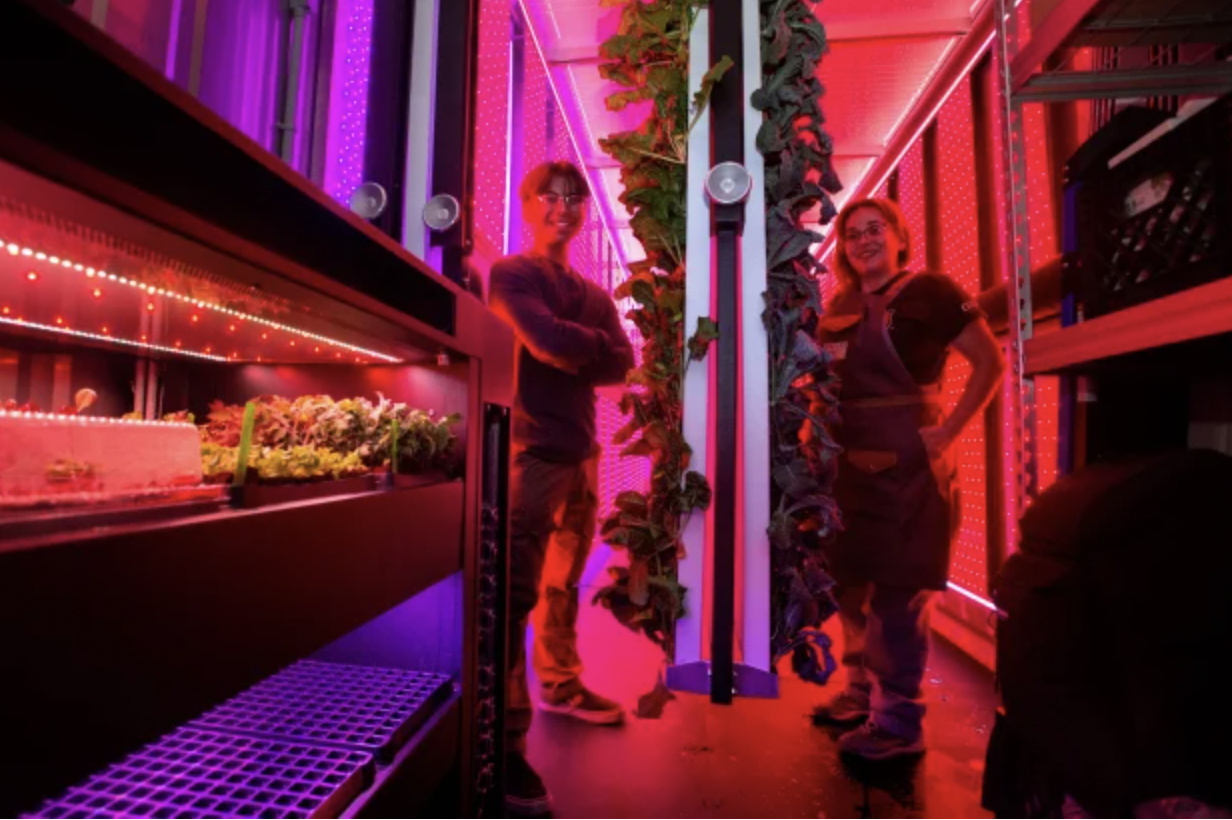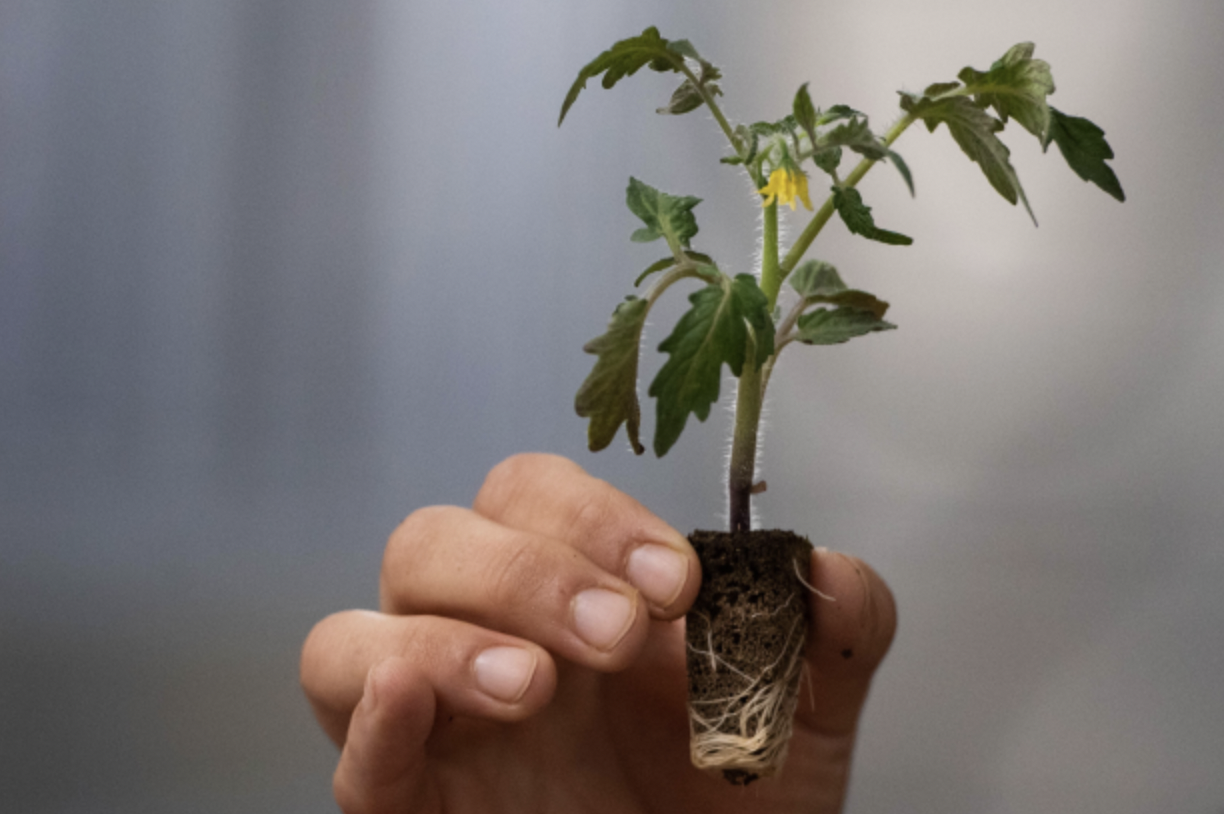USA - CALIFORNIA: CSUN Students Grow Robust Vegetable Crops Inside A Freight Container
July 15, 2022
Waiting to grow into green leafy plants, hundreds of seeds are being nursed in a mix of peat moss and coco cork formed into tiny cubes and germinated — inside a freight container set up to grow hydroponically on the campus of Cal State Northridge.
Once they are a proper size, the plants will be transferred to four ceiling-to-floor panels hanging inside the container where the plants are watered and fed the nutrients necessary to flourish into edible food.
The entire process is done through hydroponics, a type of horticulture using water-based mineral nutrients instead of soil and a lighting and a cooling system that keeps everything in check.
The goal is not only to provide leafy greens to students who may otherwise go without, but the customized metal container also serves as a “classroom” for those studying horticulture. The system is manufactured and customized by Boston-based Freight Farms, a global company founded a decade ago.
Along with professors from the university’s Institute for Sustainability, the operation is run by Mabel Trigueros, the food farm coordinator who has “farm hands,” aka students, under her tutelage.
The brain of the operation is software that controls the water and lights. “Some people say it’s not farming,” Trigueros said. “But I say it’s high-tech.”
Plants were chosen from a list of those believed to have a high rate of success, with some experimental choices thrown in the mix.
Rick Vanzura, the chief operating officer at Freight Farms, says 30 percent of those using their innovative growing process are, like CSUN, not-for-profit. “We have more commercial farms in colleges and universities than anyone in the world,” he said. “There are dozens of them, and we are obviously proud to be affiliated with Northridge.”
As part of the deal, Freight Farms provides resources and training to its buyers.
“When we trained with the Freight Farms folks, they recommended leafy greens based on the history of other Freight Farms throughout the nation and what their success rate has been,” food farm coordinator Trigueros said.
Copenhagen cabbage grows in Freight Farms’ hydroponic container farm at CSUN on Thursday, July 7, 2022 for the school’s food pantry. (Photo by Sarah Reingewirtz, Los Angeles Daily News/SCNG)
Mabel Trigueros, food farm coordinator and Freight Farms manager at CSUN, shows lettuce seedlings growing in Freight Farms’ hydroponic container farm where she is growing greens for the school’s food pantry under the Institute for Sustainability at the Northridge college on Thursday, July 7, 2022. (Photo by Sarah Reingewirtz, Los Angeles Daily News/SCNG)
Farm hand Thade Lagrisola, a third year CSUN student, and Mabel Trigueros, Food Farm coordinator and Freight Farms manager at CSUN, pose in Freight Farms’ hydroponic container farm where they are growing greens for the school’s food pantry under the Institute for Sustainability at the Northridge college on Thursday, July 7, 2022. (Photo by Sarah Reingewirtz, Los Angeles Daily News/SCNG)
Mabel Trigueros, food farm coordinator and Freight Farms manager at CSUN, shows lettuce seedlings growing in Freight Farms’ hydroponic container farm where she is growing greens for the school’s food pantry under the Institute for Sustainability at the Northridge college on Thursday, July 7, 2022. (Photo by Sarah Reingewirtz, Los Angeles Daily News/SCNG)
Mabel Trigueros, food farm coordinator and Freight Farms manager at CSUN, shows a micro tomato seedling in Freight Farms’ hydroponic container farm where she is growing greens for the school’s food pantry under the Institute for Sustainability at the Northridge college on Thursday, July 7, 2022. (Photo by Sarah Reingewirtz, Los Angeles Daily News/SCNG)
The two-side panels used inside the freight container hang vertically and provide spaces for the germinated seedling plants to be tucked into crevices on the wall. They’re nurtured with water and amendments, in an environmentally controlled growing space.
“Once the panels are filled and are at the most capacity, depending on the plant, (it’s) essentially … equal to two acres of land,” Trigueros said. “It’s cool to think of a container that is 8 by 40 (feet), or 330 square feet of usable space, that could essentially produce two acres of plants if they were planted on land.”
The list of the leafy greens that are reliably successful in a freight container include freckled red romaine, bibb, miner’s and butter leaf lettuces, parsley, radicchio, basil, Fordhook Swiss chard, dinosaur kale and Copenhagen cabbage.
But the team is also dabbling in experimental plants like micro tomatoes, radishes and black and white chia seeds.
“(This) will provide food for our dining halls and student house,” said Natale Zappia, director of the Institute for Sustainability and associate professor in the history department.
“By growing food in these prebuilt containers, farmers have the ability to manipulate the environment. This gives them the freedom to choose plants that can only grow in specific regions, avoid extreme weather conditions and most importantly allow the food to be distributed locally rather than travel long distances to its table.”
For upperclass students like Thade Lagrisola, who is majoring in environmental and occupational health, the farm doubles as a volunteer, work-study position. Lagrisola, 20, is one of the farm hands.
He shows up once a week to help the manager prepare the seeds in 12”x24” trays with up to 288 growing cells or options where the seeds initially germinate.
Lagrisola also harvests the produce growing in the hydroponic vertical walls when they are ready to be shared with the university food pantry or planted in a more traditional dirt garden tended by students.
His work is important to his major because it is related to workplace safety and environmental health. “A lot of workers here in California had to fight for the right to have safety equipment, or not be around a lot of pesticides and harsh fertilizer chemicals, way back in the ‘60s,” he said. “Our major is deeply related to that — and farm work.”
The container is tucked away on the East side of the campus. The project cost the university about $200,000 including preparing the site, the container’s placement on top of a slab, and the completion of water and electricity connections.
It arrived in April. Planting started in early May — and the first harvest was on June 28.
Container farming was popularized beginning in 2012 by a co-founder of Freight Farms to address issues of food accessibility and food deserts.
“Now we are at the point where you can essentially grow two and a half acres worth of food in a standard 8-by-40-foot shipping container,” Vanzura said. “We have a bunch of intellectual property and customize those containers especially to be able to grow food with LED lights and a hydroponic solution.”
About 70 percent of those who buy from Freight Farms are in for-profit businesses. They include small business farmers who sell directly to consumers, inter-grocery, hospitality, hotels and restaurants.
The containers are custom designed with modified air flow, ventilation systems and technology specific to growing crops.
Freight Farms containers are used in 38 countries and all but one hold-out state in the U.S. “We are fighting mightily to get into North Dakota,” Vanzura said. “I think we are getting close.”








